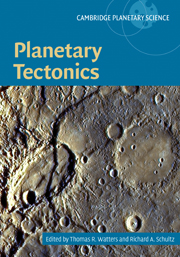Book contents
- Frontmatter
- Contents
- List of contributors
- Preface
- 1 Planetary tectonics: introduction
- 2 The tectonics of Mercury
- 3 Venus tectonics
- 4 Lunar tectonics
- 5 Mars tectonics
- 6 Tectonics of small bodies
- 7 Tectonics of the outer planet satellites
- 8 Planetary structural mapping
- 9 Strength and deformation of planetary lithospheres
- 10 Fault populations
- Index
- Plates
- References
10 - Fault populations
Published online by Cambridge University Press: 30 March 2010
- Frontmatter
- Contents
- List of contributors
- Preface
- 1 Planetary tectonics: introduction
- 2 The tectonics of Mercury
- 3 Venus tectonics
- 4 Lunar tectonics
- 5 Mars tectonics
- 6 Tectonics of small bodies
- 7 Tectonics of the outer planet satellites
- 8 Planetary structural mapping
- 9 Strength and deformation of planetary lithospheres
- 10 Fault populations
- Index
- Plates
- References
Summary
Summary
Faults have been identified beyond the Earth on many other planets, satellites, and asteroids in the solar system, with normal and thrust faults being most common. Faults on these bodies exhibit the same attributes of fault geometry, displacement–length scaling, interaction and linkage, topography, and strain accommodation as terrestrial faults, indicating common processes despite differences in environmental conditions, such as planetary gravity, surface temperature, and tectonic driving mechanism. Widespread extensional strain on planetary bodies is manifested as arrays and populations of normal faults and grabens having soft-linked and hard-linked segments and relay structures that are virtually indistinguishable from their Earth-based counterparts. Strike-slip faults on Mars and Europa exhibit classic and diagnostic elements such as rhombohedral push-up ranges in their echelon stepovers and contractional and extensional structures located in their near-tip quadrants. Planetary thrust faults associated with regional contractional strains occur as surface-breaking structures, known as lobate scarps, or as blind faults beneath an anticlinal fold at the surface, known as a wrinkle ridge. Analysis of faults and fault populations can reveal insight into the evolution of planetary surfaces that cannot be gained from other techniques. For example, measurements of fault-plane dip angles provide information on the frictional strength of the faulted lithosphere. The depth of faulting, and potentially, paleogeothermal gradients and seismic moments, can be obtained by analysis of the topographic changes associated with faulting.
- Type
- Chapter
- Information
- Planetary Tectonics , pp. 457 - 510Publisher: Cambridge University PressPrint publication year: 2009
References
- 5
- Cited by

